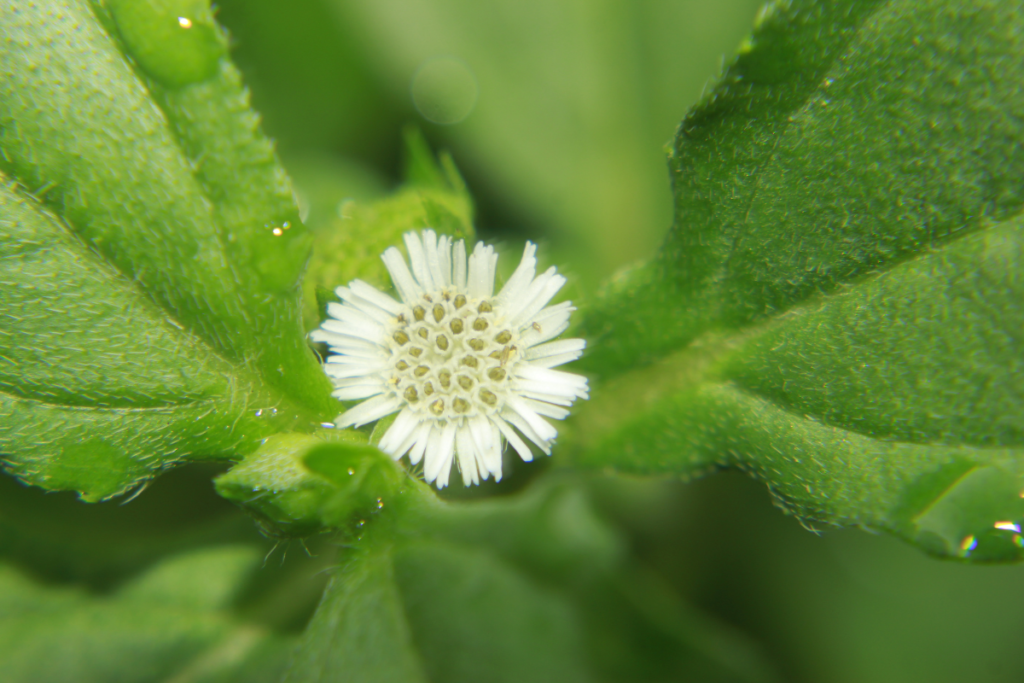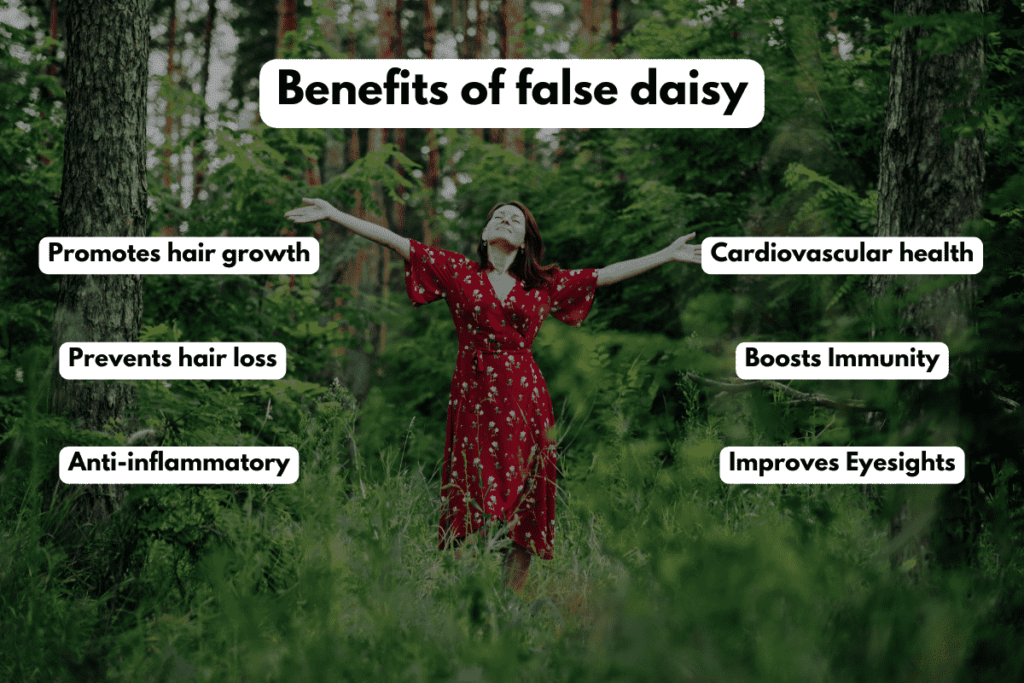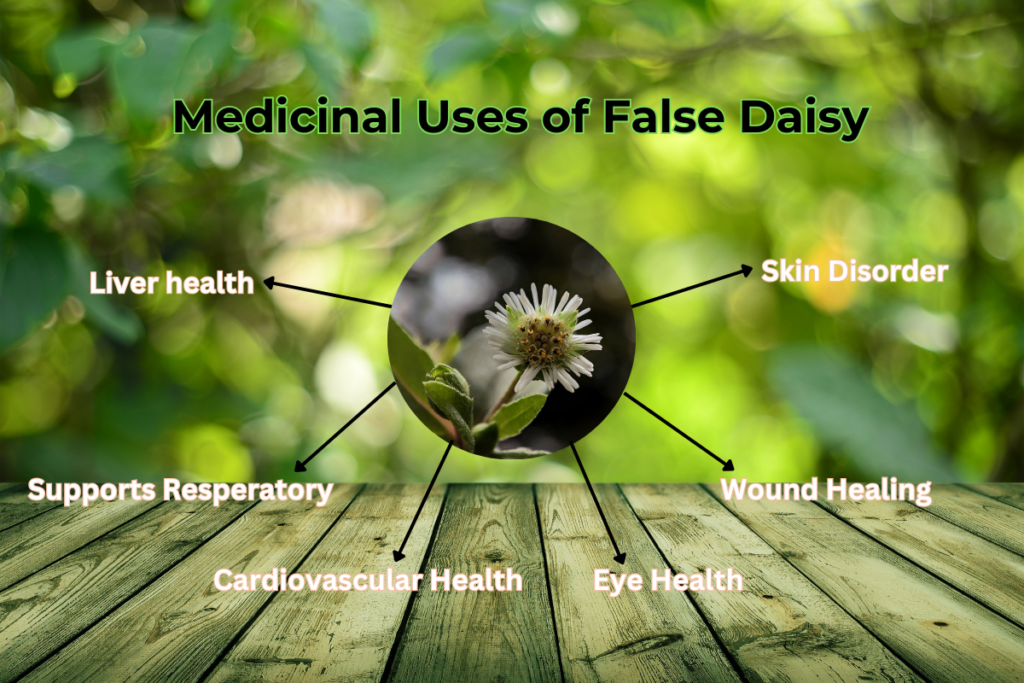Have you ever stumbled upon a plant that seems to hold the secrets of nature within its leaves? Well there is one know as False Daisy which is also known as Bhringraj. This plant has been cherished for centuries for its incredible health benefits. In the upcoming sections, we’ll explore five of its most amazing benefits and medicinal uses that you need to know about!

Table of Contents
What is False Daisy
False daisy (Bhringraj), also known as Eclipta Prostrata scientifically, is a plant in the family of sunflower(Asteraceae). Commonly it is referred to by several names, including bhringraj, yerba de tago, and karisalaankanni. This plant is native to Sub-tropical and tropical regions of the world, which include Asia, North America, and South America. In Asia it is extensively found in India, China, Thailand, and other southeastern nations. In north America it grows in Southern United States and parts of Central America while in South America it is commonly found in Brazil and other tropical countries
Benefits of False Daisy
- Promotes Hair Growth: It is particularly in the form of bhringraj oil, is renowned for its ability to stimulate hair follicles, promoting the growth of new hair. Regular use of this can also lead to thicker, healthier hair by increasing the blood circulation to the scalp / head area and nourishing the roots of the hairs.
- Prevents Hair Loss: It is very much effective in strengthening the roots of hairs, which in turn reduces hair fall significantly. By nourishing and providing the essential nutrients to the scalp helps in maintaining the health of hair follicles, thus prevents hairs from premature hair loss and breakage. Its regular use can lead to more stronger and resilient hairs.

- Improves Hair Health: This plant also enhances overall hair health by deeply conditioning and moisturizing the scalp and hair strands. Its nutrient-rich composition helps to repair damage, reduce dandruff, and restore the natural shine and softness of the hair. Consistent use can lead to vibrant, healthier-looking hair.
- Anti-inflammatory: It possesses potent anti-inflammatory properties that help reduce swelling and irritation. This makes it highly effective in treating wounds, soothing inflamed skin, and managing various inflammatory conditions. Its application can also promote faster healing of wound and skins and provide relief from discomfort caused by inflammation.
- Antioxidant Properties: This plant is also known to be very rich in antioxidants, which help neutralize free radicals and protect the body from free radical damage. This reduces cell damage or injury and lowers the risk of several chronic diseases. Consumption or application of false daisy on regular basis can enhance overall health by maintaining the wholeness of cells and tissues.
- Boosts Immunity: It is known to enhance the body’s immune response, making it more effective at fighting off infections and illnesses. By supporting immune function, it helps the body maintain optimal health and vitality. Regular use of it may contribute to a stronger immune system and improved overall well-being.
- Improves Eyesight: It has been traditionally used to enhance vision and promote eye health. It is believed to have beneficial effects on the eyes, potentially improving visual acuity and reducing the risk of eye-related disorders. Regular consumption of false daisy or its extracts may contribute to better eye health and vision.
- Supports Cardiovascular Health: it is also believed to contribute to overall heart health, though the specific mechanisms are not fully understood. It may help in maintaining healthy blood pressure and cholesterol levels, thus reducing the risk of cardiovascular diseases. Incorporating false daisy into a balanced diet may support a healthy heart.
False Daisy side effects
While false daisy (Bhringraj / Eclipta prostrata) is generally considered safe when used in appropriate doses for most people, there are a few potential side effects and precautions one should know about:
- Skin Irritation: Some individuals may experience allergic reactions or irritation in skin when using products containing false daisy. It is highly advisable to perform a patch test before applying it to larger area of the body.
- Stomach Upset: In some cases, oral consumption of false daisy may lead to nausea, stomach upset, or diarrhea. It is recommended to use it in moderation and consult a healthcare professional if one experience any of the above mentioned symptoms.
- Blood Sugar Levels: It may lower blood sugar levels, so individuals with diabetes should monitor their blood sugar closely while using it.
- Drug Interactions: It may interact with certain medications, including anti-diabetic drugs and medications that are processed by the liver. It is recommended to consult a healthcare professional before using false daisy if you are taking any medications.
- Other Possible Side Effects: Some individuals may experience headache, dizziness, or fatigue when using false daisy, although these side effects are rare.
It’s always a good idea to consult with a healthcare provider before using false daisy, especially if one has any of the underlying health conditions or are on the medications.
False Daisy Plant
This plant has been used all over the world in traditional medicine systems such as traditional Chinese medicine and Ayurveda for its various and remarkable medicinal properties. It is particularly valued for its ability to promote hair growth, improve liver health, and treat skin diseases.
False Daisy Medicinal Use
- Hair Care: It is renowned for stimulating hair follicles, promoting hair growth, and preventing hair loss. It’s commonly used in hair oils and masks to nourish the scalp and strengthen hair.

- Liver Health: It is also known for its hepatoprotective properties, aiding in liver protection and improved function. It can also be used to treat liver disorders like hepatitis and jaundice.
- Skin Disorders: This plants anti-inflammatory and antimicrobial properties make it effective in treating skin conditions such as eczema, dermatitis, and psoriasis.
- Respiratory Support: It is used to alleviate respiratory issues like asthma, bronchitis, and coughs, helping clear respiratory passages and reduce lung inflammation.
- Wound Healing: It’s anti-inflammatory and antimicrobial properties also make it useful in wound care, aiding in faster healing and reducing the risk of infections.
- Eye Health: Traditionally use of false daisy improves eyesight and treat eye conditions like conjunctivitis and cataracts.
- Cardiovascular Support: It is believed to contribute to heart health by aiding in the maintenance of healthy blood pressure and cholesterol levels. Its properties may help reduce the risk of cardiovascular diseases by supporting overall heart function. Regular use of false daisy, alongside a healthy lifestyle, may promote a healthy cardiovascular system.
- Immune Boosting: It is also believed to enhance the immune system, helping the body defend against illnesses and promoting overall health and vitality. Regular use of false daisy may contribute to a stronger immune response, supporting the body’s ability to fight off infections and maintain well-being.
ALso Read
FAQs
How do You Identify False Daisy?
To identify false daisy (Eclipta prostrata), look for its simple, opposite leaves that are lance-shaped to elliptical and range from about 2-10 cm in length. The stems can be either erect or creeping, often displaying a reddish shade. This plant produces white small, daisy-like flowers typically 6-8 mm in diameter. It is commonly grows in moist, disturbed areas, making it very much easy to spot in such environments.
Is False Daisy Herb or Shrub?
False daisy (Eclipta prostrata) or also known as Bhringraj is an herb. It is often used in traditional remedies and is very well known for its medicinal properties.
Is False Daisy Invasive?
Yes, it can be invasive, particularly in warm, moist environments where it can rapidly spread and compete with native plants. It often settle in disturbed areas, such as in the agricultural fields and roadsides, making it extremely hard to control once established.
Can We Eat False Daisy?
Yes, it is edible and is often used in traditional medicine and culinary practices in various cultures around the world. It is well known for its potential health benefits, including its use in Ayurvedic medicine for liver health, better hair growth, and many other therapeutic purposes. The leaves can be consumed either fresh or in dried form, and are sometimes used in a form of vegetable in cooking and for teas.
However, the consumption of false daisy is recommended in moderation and ensure proper identification of the plant to avoid any potential adverse effects. If you’re considering adding it to your diet or using it for medicinal purposes, it’s a good idea to consult with a healthcare professional or a knowledgeable herbalist.
What are the Nutritional Facts about False Daisy?
It is also known as Bhringraj, is rich in different essential nutrients such as vitamins (including vitamin E and C),proteins and minerals (such as calcium, magnesium, iron and potassium). All of these components contribute to its potential health benefits, including better liver health, hair growth, and providing antioxidant properties. However specific nutritional data may vary, false daisy has a high value in traditional medicine and dietary practices for its nutrient content and healing potential.
Conclusion
In conclusion, false daisy (Eclipta prostrata), known as Bhringraj, is a resourceful plant with wide range of uses and medicinal benefits. It is often used in traditional medicine practices, including Ayurveda and homeopathy, for its potential to support liver health, promote hair growth, and treat various ailments. It is also edible and rich in essential nutrients, making it a valuable addition to culinary practices in some cultures. Whether consumed as a food, used in herbal remedies, or applied topically, it also offers a natural approach to health and wellness. However, it’s important to use caution and consult with a herbalist or healthcare professional before using it into your diet or healthcare regimen.
Disclaimer: The information provided in this article is for educational and informational purposes only. Always consult with a qualified healthcare provider before using any herbal remedies, essential oils, or supplements
I am a passionate herbalist and gardening expert dedicated to sharing the transformative power of medicinal plants. With over a decade of hands-on experience, I have cultivated a deep understanding of natural remedies and sustainable gardening practices.
Driven by a love for nature and holistic wellness, My articles provide practical tips and in-depth knowledge to help you grow and use medicinal plants effectively.
